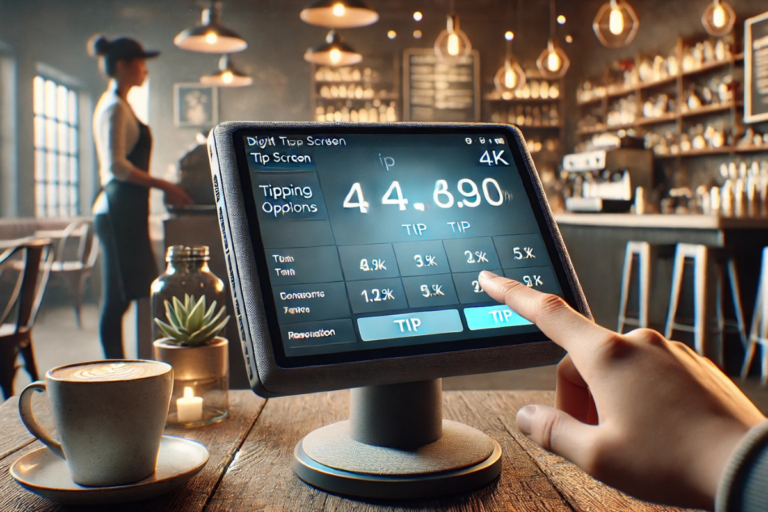Introduction to Tip Screens
What is a Tip Screen?
A tip screen is a feature you often see when using apps, visiting websites, or checking out at kiosks. It is a simple screen that asks for a tip, usually showing options like percentages or custom amounts. Tip screens are now everywhere, from coffee shops to digital platforms. They provide a way for customers or users to show appreciation for services or content.
Why Are Tip Screens Important in the Digital World?
Tip screens have become more than just a tool for receiving extra income. They represent a shift in how businesses, content creators, and service providers interact with their audiences. Instead of solely depending on traditional sales or ads, many platforms use tip screens to offer a more direct way for people to support what they value. In the digital age, where much content is free, tip screens give creators a chance to earn money from their audience’s appreciation.
Purpose of Tip Screens
The main purpose of a tip screen is to ask for voluntary financial support. It is a gentle way of suggesting that if you enjoyed the content, the service, or the experience, you can leave a small tip to show your support. For businesses, it helps boost income. For content creators, it means getting paid for the hard work they put into their content. Tip screens also build a sense of community. People who value a service feel good about contributing. This small act of tipping creates a closer connection between creators and their supporters.
Importance in the Digital Landscape
In the digital world, content and services are often free. Creators and service providers need new ways to make money. Tip screens offer a simple solution. They remind people that even small amounts of money can make a big difference. Many people enjoy supporting the content or services they love, and tip screens make it easy. As the digital world keeps growing, more creators and platforms are using tip screens. They are important because they represent a shift toward more direct support models.
Understanding Tip Screens
What is a Tip Screen?
A tip screen is a digital interface that asks users or customers to leave a tip after they receive a service or enjoy some content. You might see it at the checkout counter of a coffee shop, on delivery apps, or on websites of content creators. Tip screens typically present different tipping options, like suggested percentages (10%, 15%, 20%) or a space to enter a custom amount. It is a way for people to show appreciation for a job well done, whether it’s for a barista making a coffee or a blogger sharing useful content.
How Do Tip Screens Function?
Tip screens are designed to be simple and user-friendly. When you reach the payment stage, either online or at a physical kiosk, the tip screen pops up. It displays different tipping options, often with large buttons or clear instructions. In some cases, the options include “No Tip” to give people a choice. Once you select a tip amount, the screen updates the final total. This amount is then added to the bill, and you can complete the transaction.
For content creators, tip screens work through online platforms or plugins that connect to payment systems. A visitor or viewer can click on the “Tip” button and choose how much they want to give. Payment processing takes care of the rest, ensuring the tip goes directly to the creator. In both cases, tip screens are meant to make tipping easy and quick, removing barriers that may prevent people from leaving a tip.
Benefits of Implementing Tip Screens
Direct Income Generation
One of the biggest benefits of using tip screens is direct income generation. For small businesses, service providers, and content creators, tip screens create an easy way to earn extra money. Instead of relying only on ads or sales, businesses can receive voluntary tips from satisfied customers. For creators, this is especially important. It allows them to keep producing valuable content without always needing a big sponsorship or deal. Even small contributions from users can add up over time, providing a steady source of income that supports their work.
Community Building and Reader Engagement
Tip screens do more than just help with income. They are also great for building a strong community. When people leave tips, it shows they care and value the content or service. This builds a deeper connection between creators and their audience. It makes readers, viewers, or customers feel like they are part of something meaningful. As a result, they become more engaged and invested in what you are offering. This sense of community often leads to better interactions, more loyalty, and even word-of-mouth promotion. People enjoy supporting things they believe in, and tip screens give them a way to do that.
Enhancing Appreciation and Motivation
Receiving tips also boosts appreciation and motivation. When creators or service providers see that people are willing to tip for their work, it brings a sense of pride and gratitude. It’s a powerful reminder that what they are doing is valued and making a difference. This appreciation often motivates them to keep working hard and delivering high-quality content or service. Knowing that their efforts are recognized and rewarded can inspire even more creativity and dedication. In turn, this benefits the entire community, as supporters continue to receive excellent experiences.
Types of Tip Screens
Button-Based Tip Screens
Button-based tip screens are simple and effective. They usually appear as buttons labeled with different tip amounts or percentages. You might find these on websites, apps, or even at checkout kiosks. The idea is to make tipping as easy as clicking a button. Users can choose a tip amount quickly, and it gets added to their payment total. This type of tip screen works well for content creators, online stores, and digital platforms. It offers a fast and user-friendly way for people to show their support with minimal effort.
Embedded Tip Screens
Embedded tip screens are integrated directly into the content or platform. Instead of popping up or appearing separately, they sit within a page or post. For example, a blogger might place an embedded tip screen at the end of an article, encouraging readers to tip if they found the information helpful. Embedded tip screens blend in with the website design, making them less intrusive. They are a subtle but effective way to remind people that they can support the content they enjoy. This type is ideal for creators who want to maintain a smooth and uninterrupted user experience.
Pop-Up Tip Screens
Pop-up tip screens are more attention-grabbing. They appear as a pop-up window or overlay, usually when a transaction is about to be completed or when a user has finished consuming content. For example, after watching a video or making an online purchase, a pop-up may appear asking for a tip. Pop-ups are designed to catch the user’s attention and make a strong call to action. While they are effective, it’s important to use them carefully. If overused or poorly timed, pop-ups can feel annoying. When done right, though, they can significantly increase the number of tips received.
Setting Up a Successful Tip Screen
Choosing the Right Platform
Selecting the right platform is essential for creating an effective tip screen. Whether you use a dedicated tip plugin, a payment service like PayPal, or an integrated tool on your website, the platform should be reliable and easy to use. Consider options that suit your needs, whether you are a content creator, small business owner, or online service provider. Make sure the platform can handle secure transactions and offers features that fit your audience’s preferences.
Integrating with Your Blog’s Design
A tip screen should blend seamlessly with your blog’s design. It should feel like a natural part of your site, not an interruption. Match the colors, fonts, and overall style of your blog to maintain a professional and cohesive look. A well-integrated tip screen enhances user experience and makes tipping feel like a normal, comfortable action for your visitors.
Providing Clear Instructions for Readers
When setting up a tip screen, provide simple, clear instructions. Let readers know how they can leave a tip, why their support matters, and what it means to you or your business. A friendly and transparent approach encourages more people to contribute. If possible, add a brief thank-you message to show your appreciation in advance.
Optimizing Tip Screens for Maximum Effectiveness
User-Friendly Design Principles
Make your tip screen user-friendly. Avoid cluttered layouts or confusing options. Use large, easy-to-read buttons and keep the design clean. The goal is to make the tipping process smooth and simple so that users don’t have to think too hard about what to do.
Crafting Clear Calls to Action
A clear call to action is crucial. Use phrases like “Support Our Work,” “Leave a Tip,” or “Show Your Appreciation” to guide users. Be direct but polite, and explain the impact their tip will have. A strong call to action motivates people to take that extra step and give their support.
Ensuring Seamless Integration with Content
Your tip screen should not interrupt or annoy your readers. Integrate it in a way that feels natural, like placing it at the end of a blog post or after a video. A seamless integration ensures users remain engaged and are more likely to leave a tip without feeling pressured.
Strategic Placement for Visibility
Where you place your tip screen can greatly impact its success. Consider high-traffic areas like the end of articles, in your website’s sidebar, or as part of your checkout process. Make sure the tip screen is visible but not disruptive. Experiment with different placements to see what works best for your audience.
Offering Customization Options for Contributors
Giving contributors the option to customize their tip amount is a great idea. Some people may want to give more, while others prefer smaller contributions. By offering flexibility, you make tipping accessible to everyone, regardless of their budget.
Creative Strategies to Encourage Reader Tips
Offering Exclusive Content or Rewards
One effective way to encourage tips is by offering exclusive content or rewards. For example, you can give access to bonus articles, behind-the-scenes content, or early releases to those who leave a tip. People love feeling like they are getting something special in return for their support.
Hosting Giveaways Linked to Tipping
Hosting giveaways is another great strategy. You can organize contests where tipping gives users a chance to win a prize. This creates excitement and makes tipping feel more like a fun experience rather than just a financial transaction.
Sharing Personal Stories to Build Connection
Sharing personal stories about how tips have helped you or why you value your supporters can create a strong emotional connection. People are more likely to leave a tip when they feel personally connected to your journey or work. Be authentic and let your audience know how much their support means to you.
Utilizing Engaging Visuals
Use engaging visuals, like eye-catching images or graphics, to draw attention to your tip screen. A well-designed visual can make your tip request more appealing and memorable. It can be as simple as a creative banner or a friendly graphic reminding people to tip.
Regularly Reminding Readers About Tipping Options
Sometimes, people forget or overlook tipping options. It’s helpful to remind your readers regularly, but do it in a polite way. Mention your tip screen in newsletters, at the end of blog posts, or throu
Addressing Common Concerns and Misconceptions
Overcoming Fears of Alienating Readers
One common concern with tip screens is the fear of alienating or annoying readers. Many creators worry that asking for tips might drive people away or make the experience feel too commercial. However, when done thoughtfully, tip screens don’t have to feel intrusive. Use gentle language and offer tipping as an option, not an obligation. Emphasize that tipping is a way to support your work if readers feel inclined, not a requirement.
Ensuring Transparency and Trust
Building trust with your audience is key. Be transparent about how tips will be used. Whether the tips help you maintain your website, create more content, or cover production costs, let your audience know. People appreciate honesty and are more likely to contribute if they understand where their money is going. Transparency strengthens the relationship between creator and supporter.
Highlighting the Value Exchange Between Creator and Supporter
Make sure to highlight the value exchange that comes from tipping. Explain that tips help you continue to create valuable, high-quality content. Let supporters know that their contributions make a real difference. When people understand the impact of their tip, they feel more satisfied and connected to your work. This understanding encourages them to be more generous and engaged.
Common Mistakes to Avoid with Tip Screens
Avoiding Overwhelming Prompts
One mistake to avoid is overwhelming your audience with constant or aggressive prompts to tip. If your tip requests feel pushy, they may turn people off. Keep your tip screen simple and friendly. Make sure it appears at appropriate times, like after a user has consumed content or completed a transaction, rather than popping up repeatedly.
Ensuring Mobile Optimization
Many people browse websites and consume content on their mobile devices. Make sure your tip screen is fully optimized for mobile use. A screen that doesn’t work well on smartphones or tablets can frustrate users and lead to missed opportunities for tips. Check that your buttons are easy to tap and that the tip screen looks good on all screen sizes.
Personalizing Messages to Readers
Another mistake is using generic or robotic messages. Personalize your tip screen to connect with your audience. You can include a thank-you message or a brief note about how tips make a difference. A personalized touch makes readers feel more appreciated and valued. It turns a simple tip request into a warm and engaging experience.
Monitoring Analytics for Performance
It’s important to track how well your tip screen is performing. Use analytics to see how many people are interacting with it, which placements work best, and what times generate the most tips. This data helps you make informed decisions and improve your strategy over time. Skipping this step can mean missing out on valuable insights.
Timing Requests Appropriately
Timing is everything when it comes to tip screens. Asking for tips too early or at the wrong moment can be ineffective. Wait until readers have engaged with your content or completed a purchase before presenting the tip screen. The right timing can make tipping feel natural and less like a sudden interruption.
Case Studies and Success Stories
Examples of Bloggers Successfully Using Tip Screens
Many bloggers have successfully implemented tip screens and seen great results. For instance, some content creators report that adding a tip screen at the end of valuable articles led to a significant increase in support. Sharing these examples can inspire you to set up your own tip screen and show how it can work in different niches.
Lessons Learned and Best Practices
There are many lessons to learn from those who have tried and tested tip screens. Successful bloggers often emphasize the importance of placement, clear messaging, and user-friendly design. They also stress the value of expressing gratitude and staying authentic. Following these best practices can increase your chances of success and make tipping a positive experience for everyone.
Conclusion
Tip screens have become an essential tool for creators, small businesses, and service providers looking to generate direct income while engaging and building a supportive community. When implemented thoughtfully, tip screens offer a seamless way for audiences to show appreciation and feel more connected to the content or service they value. By choosing the right platform, integrating tip screens smoothly into your design, and using clear and friendly language, you can create a positive experience for both you and your supporters.
As the digital landscape evolves, embracing tip screens can lead to sustainable growth and long-term success. Remember to be transparent, optimize for mobile users, and monitor performance regularly to make the most of your tip screen strategy. Ultimately, the key is to make tipping feel like a natural and rewarding experience, fostering a culture of appreciation and support that benefits everyone involved.


